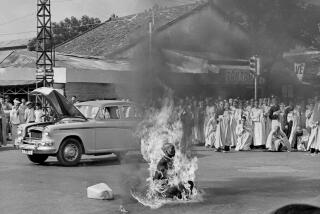One Man, One Soul : EMERSON: The Mind on Fire, <i> By Robert D. Richardson Jr. (University of California Press: $35; 671 pp.)</i>
Henry David Thoreau once noted that âA muskrat trapper like John Goodwin worked indoors in all weather, consuming little fuel; Emerson sat at his desk and burned many cords of wood.â And it seems that sitting in his study and writing, when not on the road giving lectures, was Emersonâs principal occupation. He had a family with his second wife, he put a fair amount of thought into a fruit orchard, but mostly he read and wrote, burning, as Thoreau says, many cords of wood.
Despite that, Richardsonâs 671-page biography of Emerson is a page turner. The adventures are the adventures of a reader. And, of course, a thinker, a writer. The adventure is vivid; this is the Emerson who wrote at one point, âHenceforth I design not to utter any speech, poem, or book that is not entirely and peculiarly my own work.â These are not the remarks of someone for whom writing is a genteel occupation, but of someone for whom âthe way to write is to throw your body at the mark when the arrow is spent.â Emerson was not a mere âcontributorâ to American letters, but the writer whose passions and rigors helped to define what it means to be an American and to be serious about yourself and writing. The fire that Emerson burned all of his life sustained nothing less than prophesy . . . and it took prophesy to carve letters out of the young, raw, unfinished nation.
For Emerson, the human mind is a flame. And each individual mind is part of âone central fire, which, flaming out of the lips of Etna, lightens the capes of Sicily; and, now out of the throat of Vesuvius, illuminates the towers and vineyards of Naples. It is one soul which animates all men.â Richardson tells the story of this fire, and its fading, well; in part by sticking close to Emersonâs own words Richardson enables the reader to begin to understand the difference between Emerson and, say, undisciplined New Age enthusiasm, though in the end it is only the essays themselves, in their grandeur and rigorous scope and paradox.
âEmerson: The Mind on Fireâ begins with a description of Emerson opening his wife Ellenâs coffin at a moment of a crisis of faith, and shortly before resigning his pulpit, moving his mother, selling his furniture and setting sail for Europe. The preface tells us that the book was originally intended as a companion to âHenry Thoreau: A Life of the Mind,â but that the story proved in Emersonâs case to be inseparable from his âpersonal and social life.â Richardson says of his book, that âWhere this biography parts company with its many worthy predecessors is in its lack of interest in institutional Emersonianism--in Emersonâs influence--and in its concentration instead on the man.â
But there are difficulties with this sporting goal. Richardson is overly careful to give us a politically correct Emerson, one with the right views on slavery and women--and at such points in Richardsonâs book we are not alone with Emerson but rather picking up on current academic debates.
And it is of course Emersonâs influence that prompts 573 pages plus notes and index about this particular New Englander whose habits, when he was at home, seem to have been fairly steady. The thinker for whom all thought was fire--volcanic fire--is shown to us on his last night in his study carefully taking his fire apart and separating the glowing coals before retiring to bed. Emersonâs influence cannot be canceled from a story as easily as all of that--shunning âthe institutional Emerson,â is, for instance, a very odd way to refuse to take up the Emerson who has been read by Freidrich Nietzsche and Wallace Stevens, by Harold Bloom and Stanley Cavell. These people are institutional in the same ways Emerson is--not the way a list of required reading is, but rather the way a landscape is, at once that naturally and that artfully.
But the Emerson Richardson gives us also enables the contemporary reader to start to make some sense of the ways this archetypal American thinker has, for all of his influence, failed to have a steady, easily located institutional self. He is read, presumably, in American Studies courses, but he is little read in philosophy courses, and I agree with Stanley Cavell who has been urging us to read Emerson as a philosopher. Yet I have learned recently of a graduate student in a philosophy program who had never heard of Emerson. This cannot be blamed on television, but rather on some peculiarities of American history that give us the thinker about whom James Russell Lowell said, âWe are socially and intellectually moored to English thought till Emerson cut the cable and gave us a chance at the dangers of glories of blue water.â Emerson is enormously influential, but outside of the philosophical canon, as though his influence were always to be illicit.
I read âEmerson: The Mind on Fireâ with gratitude and admiration. But the job has not yet been done of making sense of the Emerson we inherit largely by failing to inherit him, the founding figure of American philosophy whose works are fugitive in modern philosophy departments. This was not, of course, Richardsonâs goal--indeed he says clearly that his goal is to treat the man, and not his influence. But for me questions about Emersonâs influence and current existence as part of the configuration of American letters pull and nag at Richardsonâs pages. That is not to say that I would wish the book to be any different.
More to Read
Sign up for our Book Club newsletter
Get the latest news, events and more from the Los Angeles Times Book Club, and help us get L.A. reading and talking.
You may occasionally receive promotional content from the Los Angeles Times.







